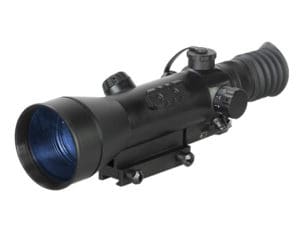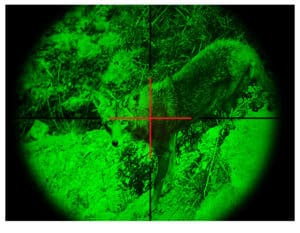 Night vision technology has been an interest of mine for a number of years. It has plenty of uses, particularly if your interests run to camping, hiking after dark, or observing nocturnal wildlife. I can still remember the first scope I picked up amost 15 years ago – a Gen 1 commie surplus model at a photo/video show that provided some decent amusement for about a year or so until it died a sad death. Since I live in the Northeast, things get kind of dark around here fairly early in the late fall and winter, so as my rifle collection grew, my thoughts once more returned to night vision technology. . .
Night vision technology has been an interest of mine for a number of years. It has plenty of uses, particularly if your interests run to camping, hiking after dark, or observing nocturnal wildlife. I can still remember the first scope I picked up amost 15 years ago – a Gen 1 commie surplus model at a photo/video show that provided some decent amusement for about a year or so until it died a sad death. Since I live in the Northeast, things get kind of dark around here fairly early in the late fall and winter, so as my rifle collection grew, my thoughts once more returned to night vision technology. . .
Night vision scopes are classified by their generation which refers to the level of technology used to resolve an image. In a nutshell, a night vision device (NVD) collects ambient light and passes it to a photo cathode tube which converts the photons to electrons that in turn are amplified, then hurled against a phosphorus screen where they are converted from electrons back to photons so that the human eye can perceive an image.
As you ascend the various generations, the NVDs get progressively better at capturing available light and converting it to a useful image. Also, as you move from Gen 1 to Gen2 to Gen 2 and higher, the lifespan of the photo cathode tube increases, too. Unfortunately, while Gen 1 gear starts in the mid- 100’s, as you move up from Gen 1 to Gen 2, you can expect to tack on an additional $1,000 or so. Move from Gen 2 to Gen 3 or from Gen 3 to Gen 4 and you are looking at approximately $1,500 – $2,000 for each step up. This means that you will pay roughly 10X more for a Gen 4 device as you would for a Gen 1.
ATN has been around the block for awhile in the Night Vision game. They also offer some way cool thermal stuff, but if you think that Gen 4 gear costs a lot, then you haven’t priced thermal technology lately. Since I had experience with Gen 1 and found it lacking, I decided to move upmarket as much as my budget could afford. This landed me squarely in the Gen 2 realm.
ATN, like any other company with a decent marketing department has pushed pretty hard for further stratification between the night vision generations. Between Gens 2 and 3, they offer two sub-levels – Gen CGT and Gen HPT. Both of these intermediate steps offer increased sensitivity and resolution over the fundamental Generation 2 technology and approach Generation 3 performance, but at a lower price.
I chose to go with the Night Arrow 4 CGT scope for a couple of reasons; first, as a CGT system, it boasted better performance than the Gen 2 version that I had been thinking about. Second, I was able to purchase a reconditioned one at about a $300 discount from the new price. This meant that I could afford the CGT technology for less than I had expected to pay for Gen 2. The downside to this was that I was unfortunately locked into 4x magnification. This scope is offered in 2x, 4x, and 6x versions with approximately $100 separating them. ATN also offers an unmagnified night vision system designed to work with your existing scope, but the cost for that unit was $400 more, so I passed.
I field tested this system last night at the range mounted atop my Sig Sauer 516 patrol rifle. While the 4x magnification proved good for shooting from the 50 yard line and acceptable for shooting from the 100 yard line, any further and my ability to focus on the targets was seriously compromised. I would ultimately have preferred the 6x magnification and would have happily paid the extra $100, but since I was buying reconditioned, I had to take what I could get.
The ATN Night Arrow ships with an IR illuminator. Think of this as essentially an infrared flashlight. NVDs are designed to amplify available light, but what happens when there is no ambient light of any kind, for instance on a moonless, overcast night? What if you are operating inside a building with absolutely no light? That’s where the IR illuminator comes into play. It casts a bright IR beam over the scene in front of you that your NVD is able to see.
There are two downsides to the IR illuminator, though. First, as powerful as it is, it is only effective to about 100 yards and that’s pushing it. Anything beyond that is not likely to be illuminated by the IR source. Second, despite what you may think, it’s not invisible to the naked eye. After doing some research, I found out that the illuminators in the IR spectrum run from about 730 nm to 950 nm. IR illuminators that operate at the lower end of that spectrum give off a red glow that is very visible from a distance. At 850 nm, the IR beam gets progressively more difficult to see, and anything beyond 940 nm is completely invisible. You do however trade stealth for distance as the higher the frequency, the less visible the IR light is to your NVD.
The Night Arrow (and pretty much most of ATN’s offerings) ship with an IR illuminator that falls in the low end of the spectrum. It’s probably not a big deal in most cases, but I wouldn’t suggest using it for counter sniping operations unless you want the bad guys sending rounds your way.
The Night Arrow has the traditional green NVD glow, but adds a crosshair that has its center illuminated in red:
 The system works very well, but there are some caveats. First, the reconditioned model that I received was not all that well reconditioned. The illuminated red cross worked for a few minutes, then went out although the rest of the scope worked well. Additionally, the IR illuminator would work with a new battery inserted, but if you flipped it off, it would not come back on again until you removed and replaced the battery.
The system works very well, but there are some caveats. First, the reconditioned model that I received was not all that well reconditioned. The illuminated red cross worked for a few minutes, then went out although the rest of the scope worked well. Additionally, the IR illuminator would work with a new battery inserted, but if you flipped it off, it would not come back on again until you removed and replaced the battery.
ATN offers a two year warranty on their NVDs, but it’s not extended to reconditioned merchandise such as this one, which is why I am returning it. I think that ATN’s products are reasonably priced and work well, but make sure you purchase it from an authorized reseller in case you need service.
Bear in mind too that these things are not lightweights. Figure adding 3+ pounds for the main scope plus another half pound or so for the IR illuminator. The kit comes with a decent cloth carry bag and the Night Arrow ships with a base that has a Picatinny rail mount built in.
While you can certainly purchase a NVD that’s not designed for weapons mounting for a couple hundred dollars less, I decided to go with the Night Arrow as it gave me the flexibility to use it as a weapon scope or off the rifle as a general purpose NVD. Despite the issues with the reconditioned scope, I like what I’ve seen with the ATN line and plan to replace this scope with a new model from them soon.




Amaze your friends! Embarrass your neighbors! Get arrested!
Okay, night vision is cool, but it will never replace those X-ray glasses that I once bought from an ad in the back of a comic book.
You spent a lot of money on a reconditioned unit that didn’t work correctly? That has to suck. I think I would have dropped the extra $300 and gotten the 2 year warrantee on a new one if at all possible. Let us know how you make out returning it, do they stand behind their product?
Yep. Fortunately I bought it from Amazon’s Warehouse bargains site, so they take it back no questions asked. I was not actually aware of ATN’s strict warranty policies before I purchased it, but am now. Instead, I purchased a “B” grade unit directly from ATN. They claim it has some small defects (I couldn’t see any) and sell it for about $350 less than the current model could be had on the street. Plus, since its from them, it has the full warranty.
I’ve tried three ATN devices and they were all junk. I’ve also noticed that many places selling them sell AS IS and will not except returns
I agree, I purchased a night arrow x 4, it worked once never worked again, I wrote ATN but they wouldn’t answer my letter, so I wrote Cheaper then dirt from whom I purchased the scope from, they said” sorry we can’t help and this why we no longer sell ATN products for the reason you state, we suggest that you not buy any more of their products ” So I guess that I’m out $1,225.00. So I would agree with you it’s pure junk
been there, I should disagree with you. probably you tried first or second gen night vision devices. to really evaluate a quality of this technology you should try gen 3 or at least white phosphor.
http://techeyes.com/atn-mars-4x-wpttm.html check it our this link for me. and read carefully
I had trouble getting past the part where you state that 4x wasn’t adequate to get past 100 yards, and you would have needed the 6x to do it. As someone who regularly hit a 300 yard man sized silhouette with iron sights during qualifications in the Army, I think I need some clarification of this statement. Was this an issue of the digital image quality, or are you expecting to hit a golf ball at that distance?
Comments are closed.